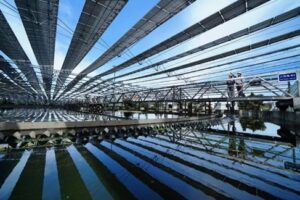Making China’s Water Industry Carbon Neutral
Energy consumption within the water industry contributes to global carbon emissions, while there are also process emissions from nitrous oxides and methane emissions in wastewater systems. According to IWA’s WACCLIM initiative, the widespread use of outdated or inappropriate treatment technologies and pumps leads to unnecessarily high carbon emissions from energy use, and of methane and nitrous oxide from wastewater treatment processes. Therefore, water sector companies have a big role to play in reducing carbon emissions and improving energy efficiency to help meet the internationally agreed target of well below 2°C rise in global temperature.
Within China, Beijing Drainage Group (BDG) is taking the lead in the wastewater sector and proactively finding innovative ways to achieve carbon neutrality, in line with the country’s strategy of eco-environmental progress. This strategy aims to respond to the national goals of peaking carbon dioxide emissions by 2030 and achieving carbon neutrality by 2060. BDG intends to identify three innovations and ten specific measures to achieve carbon neutrality by minimizing its carbon footprint while maximizing the use of renewable energy. BDG has developed a plan to reducing carbon emissions and achieving carbon neutrality in China’s water industry, below are the three main fields of innovation and related measures identified in the plan.
1) Enhancing carbon reduction with operational innovation
Smart operations will pave the way for the ecological transition, allowing companies to regain control over their assets and operations and preventing unnecessary energy consumption. For example, BDG will carry out integrated and optimized ‘sewer-plant’ operation control, refine operation management, increase equipment efficiency, and utilize smart water modeling to achieve high management efficiency and effectiveness.
2) Promoting carbon substitution through scientific and technological innovation
Advances in carbon substitutes will be required for the water sector to permanently divert from fossil fuels. Innovations in this field have the potential to turn the water sector green. BDG will explore new low-carbon technologies in the industry and promote self-development of low-carbon technologies such as anammox and aerobic granular sludge technologies, and will speed up the transformation and application of research results. In addition, green and low-carbon technologies including biogas cogeneration plants, distributed photovoltaic power generation devices and water source heat pump systems will be widely applied and installed in BDG’s facilities to realize low-carbon green production.

Photovoltaic power generation device
3) Encouraging carbon sequestration through ecological services innovation
BDG will step up the beneficial use of reclaimed water and treated sludge by supporting new models of circular economy to realize ecological carbon sequestration. For example, a highly efficient ecological carbon sink has been achieved through the use of quality biosolids produced by advanced anaerobic digestion in land application and land restoration, and the reuse of reclaimed water in constructed wetlands. BDG’s Carbon Neutralization Implementation Plan contains ambitious goals and targets, such as achieving carbon neutrality by 2050. Hopefully, the plan will inspire many other water companies to follow suit and adopt more eco-friendly and smart approaches to water management.

